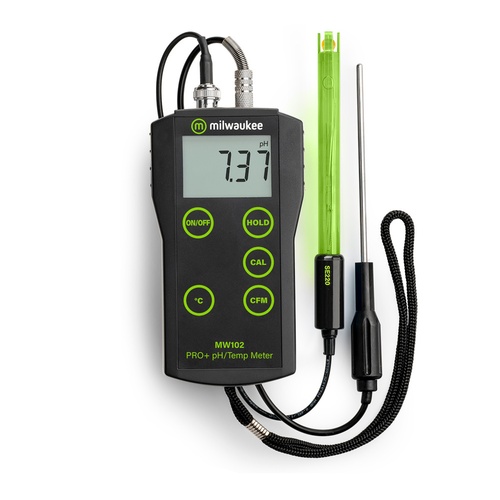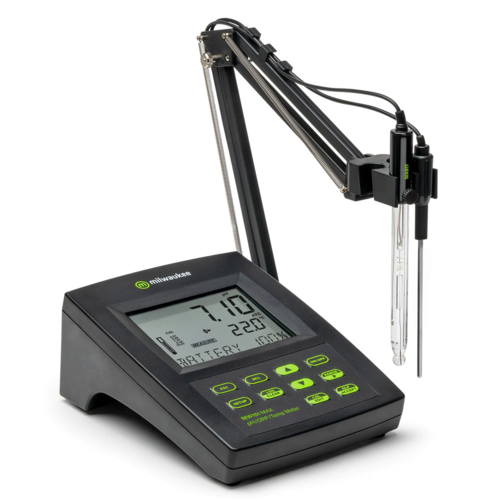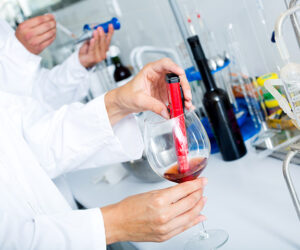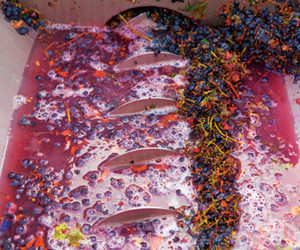After some convenience items like a racking cane and a wine thief are added to your winemaking equipment arsenal, a quality pH meter should be one of your next investments. Being able to get an accurate read on where your wine’s pH lands on the spectrum has huge implications not only for flavor and balance, but more importantly its microbial stability and impact on sulfite additions. It is probably the single most important number you can obtain while making wine.
pH Meter Basics
While the exact science of how a pH meter works is not all that important, a basic explanation is that the probe you submerge in your solution (wine) is reading the level of hydrogen ions. Because of the chemistry involved, pH meters are temperature-sensitive and readings can change depending on the temperature of your solution.
pH meters must be calibrated before each use with two solutions designed to specifically read pH at a certain level. These are generally referred to as calibration reagents or buffers and the two that winemakers want to always have on hand is one at pH 4.01 and the other at pH 7. These reagents do need to be replaced periodically, so be wary of the expire date. Also be sure to secure the caps back on when finished with each use since evaporation will affect the reagents’ ability to properly calibrate your meter.
Finally, your pH meter’s probe needs to always be stored in one of the calibration reagents or in designated pH electrode storage solution and should never be left to dry out or stored in distilled water. There is a solution inside the probe that once dry will need to either be replaced or the whole pH meter will need replacing, depending on the model pH meter you choose.
Choosing a pH Meter

While there is the more affordable option of getting pH test strips, an investment in a decent-grade pH meter is highly recommended for anyone who wants to take their winemaking to the next level. A quality stick-type pH meter will start around $50, but can range up above $100 for the higher-end stick meters. Sticks are easy to use and a small footprint makes them easy to take with you and store away. The higher-end stick pH meters will have a feature called ATC, or automatic temperature correction, as well as enhanced pH precision. The beauty of the ATC feature is that if your juice is cold, it will adjust pH readings to correct the variance. One of the major issues with stick pH meters is that their design is really for handheld, quick readings. More advanced winemaking lab skills will find these shortcomings to be problematic.

Next up are the portable pH meters which, like stick pH meters, are easy to transport, but do have a slightly bigger footprint. These are a good mid-range meter that often will feature ATC and may or may not provide the precision of a stick pH meter. That depends on the models you are looking at. These start around $120 for a quality model with ATC.

A bench-top pH meter is only for beginning winemakers who believe in the “buy once, cry once” philosophy. A top-end, laboratory-grade model can run over $1,000, but more affordable options generally start in the $200 range. These should feature ATC as well as improved accuracy, precision, and the ability to replace the probe in case of failure. Many of these also now offer some sort of technological interactions as well, allowing you to log or chart readings to a computer or app. For those that want their pH meter to grow with their hobby, you’ll want to invest in one. But besides the higher price tag, they also have a bigger footprint and lack the portability aspect.
Finally, choosing a known manufacturer like Hanna, Milwaukee, or Vinmetrica is a good choice for winemakers since they are well-known in the wine world and folks can easily get advice on them from fellow winemakers. Also, a precision level of ±0.01 is more than enough for even picky home winemakers. Steer clear of meters with more than ±0.1 pH precision as that is not good enough for winemaking.
pH Meter Uses
Getting a pH read on fresh juice or grapes is going to be key for several possible winemaking additions. Generally white and rosé winemakers are looking for juice to fall in the 3.0–3.4 range while red typically should be between 3.2–3.6. Winemakers can either acidify the juice or de-acidify if the juice falls far outside of its respective range. These are just generalizations though and should not be used as gospel. Other factors such as TA, or titratable acidity, may also be a factor. But if wine pH is too high, there are several potential problems, most notably: The wine is much more susceptible to infections, more sulfites are needed as pH rises, and wine often tastes flat (lacking any bite). When pH is too low yeast and other microorganisms winemakers want may struggle. It may also be overly harsh/sour on the palate.
A pH meter can offer more for winemakers than just getting a read of a juice or wine’s pH. With a few extra pieces of equipment, most notably a burette, winemakers can also get the TA levels as well (another important measurement for winemakers in tandem with pH). TA readings can be performed without a pH meter using phenolphthalein as a pH indicator, but the problem is that the indicator is pink and therefore does not work well on red wine. For that reason, it’s only suited for TA readings with whites . . . and you are much better off with a pH meter anyway.






